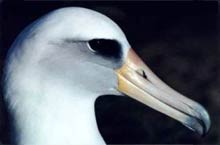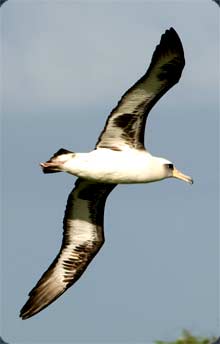|

April 30, 2008
. . . is an albatross, breathing fishily in my face and weighing on my conscience: the links I haven’t given you yet to two tales that connect to April’s cover story about albatrosses, “Around Their Necks.” Both concern North Pacific islands where albatrosses nested, and still nest, and between them they tell the story of our evolving relationship to the other life forms with which we share this planet.
“The Bird Tragedy of Laysan Island” is Chapter 14 of a book called Our Vanishing Wild Life: Its Extermination and Preservation, by William Temple Hornaday (do a “find” on the page for “CHAPTER XIV” to reach the chapter). The entire book can also be downloaded for free. For all its torn-from-the-headlines title, this book was published in 1913, and the part at this link deals with the wholesale slaughter of birds for the millinery industry—to adorn women’s hats.
The tone of the book takes some getting used to. A review in the New York Times (PDF) described it as “fervent” and “glowing with impassioned appeal.” It shows that environmental indignation, like environmental exploitation, was more florid and explicit a hundred years ago. We can’t match our great-great-grandparents for either shameless butchery or high dudgeon. Oddest of all to us, who expect to see ecology and feminism hand in hand, is that female vanity is Hornaday’s villain, along with the commerce that catered to it. (PETA’s anti-fur campaigns have touched on the same theme, but without the note of cheerful misogyny.) New York had already banned the trade in feathers from native wild birds, but the ransacking of the winged world outside U.S. borders went on unconstrained, and the feather markets of London and Paris were booming.
The chapter about tiny Laysan Island, where Laysan and black-footed albatrosses nested thickly among terns, petrels, boobies, shearwaters, and man o’ war birds, recounts the systematic slaughter of at least three hundred thousand birds by American-owned ships from Honolulu, staffed by Japanese laborers. One man was responsible: a German immigrant named Max Schlemmer who was known as the King of Laysan.
Actually the birds were not killed outright; their wings were merely cut off, and they were left to die while their young starved. Hornaday quotes appallingly vivid eyewitness accounts of the island before and after (some much more graphic than I’m quoting):
[T]he bird life on Laysan has been regarded as one of the wonders of the bird world. One of the photographs taken prior to 1909 shows a vast plain, apparently a square mile in area, covered and crowded with Laysan albatrosses. They stand there on the level sand, serene, bulky and immaculate. Thousands of birds appear in one view—a very remarkable sight. . . .

Naturally man, the ever-greedy, began to cast about for ways by which to convert some product of that feathered host into money. . . .

“This wholesale killing has had an appalling effect on the colony. . . . It is conservative to say that fully one-half the number of birds of both species of albatross that were so abundant everywhere in 1903 have been killed. The colonies that remain are in a sadly decimated condition. . . . Over a large part of the island, in some sections a hundred acres in a place, that ten years ago were thickly inhabited by albatrosses not a single bird remains, while heaps of the slain lie as mute testimony of the awful slaughter of these beautiful, harmless, and without doubt beneficial inhabitants of the high seas.” . . . .

In February, 1909, President [Theodore] Roosevelt issued an executive order creating the Hawaiian Islands Reservation for Birds. In this are included Laysan and twelve other islands and reefs . . . . By this act, we may feel that for the future the birds of Laysan and neighboring islets are secure from further attacks by the bloody-handed agents of the vain women who still insist upon wearing the wings and feathers of wild birds.
That was a turning point. (Interesting how many people lately feel in tune with Teddy Roosevelt’s combination of hearty but regulated capitalism and virile conservationism, as well as his soft speech and big stick.) Hornaday documents other landmark victories in the battle to shut down the wild feather trade, the founding cause of the Audubon Society—spearheaded by women. Audubon Magazine called it “the episode that set the cornerstone for 20th-century conservation laws.”
Today, the Audubon Society reports that the albatross breeding colony on Laysan, unlike some on other decimated islands, has “partially recovered”—introduced rabbits have damaged their habitat—but that overall, the Laysan is now the most abundant Northern hemisphere albatross, with a population of 2.5 million. Close to half a million of them nest on another island in the Hawaii Archipelago with a unique history of human-bird coexistence: Midway Atoll.
When Midway became a commercial aviation way station in the 1930s, a naval staging base and battlefield of World War II, and a critical Cold War airbase, the hundreds of thousands of Laysan and black-footed albatrosses that nested there came into conflict and often collision with Pan Am’s and the Navy’s metal “birds.” Perhaps if the soldiers, who dubbed them “gooney birds” for their awkwardness on land, had not known of the old sailor’s superstition that it’s bad luck to kill an albatross, the real birds would have fared much worse. As it was, they were subject to control measures (PDF) from scare-away tactics to leveling and paving of habitat to culling of eggs and adults. (Albatrosses lay only one egg per year, and they mate for life; a bird that loses its mate will only rarely pair and reproduce again the next year.)
As the Cold War wound down, however, and decommissioning of the base began to seem likely, a transition began “from bullets to birds,” overseen first by the Navy, which began a massive cleanup and habitat restoration, then by the Fish and Wildlife Service, which took over the island’s jurisdiction in 1993. Today the gooneys own the island again, and ecotourists and FWS volunteers are their guests. The new threat to their well-being is plastic trash, bits of which albatross parents mistakenly feed to their chicks, with fatal results for up to a third of them.
Vanity is no longer the human sin that’s deadly to the albatross. Now it’s—what to call it? Speaking of new deadly sins, what’s the one word, like “gluttony” or “sloth,” that describes pitching vast amounts of toxic, entangling, indestructible trash into the land and sea? Any suggestions? In my opinion, anything with “eco-“ in it is too tidy and prim. It calls for a word of Biblical blunt force. Maybe something like “slobbery” or “sloven.”
Bonus materials:
Here’s an uncondescending, information-packed kids’ Web page about albatrosses where you can compare your “wingspan” to theirs and learn about their “yucky child care” (regurgitation alert!).
Here’s a superb explanation of the salt-excreting supranasal glands that enable albatrosses and other seabirds to drink seawater. It does not tarnish the lucid complexity or scientific accuracy of the explanation—which could stand alone—that at the very end of it, its author uses the salt gland’s incredible intricacy as an argument for intelligent design.
Here’s the story of the wonderful man who exclaimed in a 1912 missive from the Southern Ocean to his bride, “I now belong to a higher cult of mortals, for I have seen the albatross!” He was the Long Island-born ornithologist and conservationist Robert Cushman Murphy. Named after him: “a feather louse partial to the albatross, . . . two mountains, Mount Murphy in the Antarctic and Murphy Wall in the South Georgia Islands, a spider, an Antarctic inlet, a plant, a fish, three species of birds, a park and a junior high school in Stony Brook, near his house in Old Field.” Now that’s immortality.
And here’s Coleridge’s “The Rime of the Ancient Mariner,” so you don’t have to look it up.


(Annie Gottlieb) |
Comments (add yours!)

Return to April home
|



